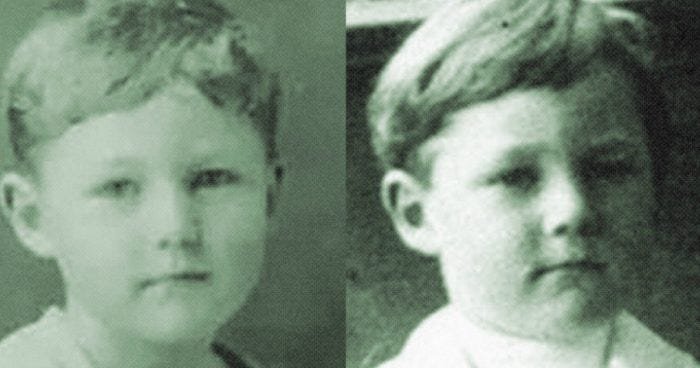In the early 19th century, the grass wasn’t the only blue thing in Kentucky.
The year 1820 saw the arrival of French immigrants Martin Fugate, and his wife, Elizabeth Smith, to an undeveloped area in the eastern region of the US state.
While the Fugates were in possession of a land grant and could have chosen somewhere closer to a small town to live, they didn’t.


They set up a homestead alongside a tributary of the North Fork Kentucky River known as Troublesome Creek. There, they led an impoverished existence, subsisting on what they could produce from the land.
The Fugates didn’t choose such an isolated location to settle because they were an antisocial couple, but because the society of the times found it hard to accept Martin. He was very different from everyone else. Martin Fugate was blue.
The Blue Fugates
A few years after they’d settled, Martin and Elizabeth’s family had grown in number. They had seven children, and unfortunately for them, four of those children inherited Martin’s blue skin.
As is only natural, the Fugate’s children grew up, married and had their own children. During that era in rural Kentucky, where the communities were minimally populated, it was common for young folks to marry their cousins.
That’s a practice which remained legal until the 1940s. Those intermarriages between close relations created a concentrated gene pool, and more blue Fugates were born.
At the time, nobody knew or understood why the hue of the Fugate’s skin was a dark indigo color. It would take until the 1960s before someone was able to finally solve the mystery.
Who Discovered Why The Fugates Were Blue?
Life, times and locations change with progression. By the early 20th century, Troublesome Creek was no longer an isolated rural hideaway. A town, Hazard, had developed nearby.

When the Louisville and Nashville Railroad ran a line through the town, it experienced economic growth and became a transport hub for mining and logging operations.
As more people travelled in and out of the area, word of the existence of the Blue Fugates of Troublesome Creek began to spread.
But even so, the Blue Fugates remained a local curiosity until a haematologist at the University of Kentucky Medical Centre and School of Medicine heard about them.
That haematologist was Dr Madison Cawein III. Obsessed with his work and fascinated by what he’d been told about the Blue Fugates, Dr Cawein travelled the 150 miles from Lexington to Troublesome Creek to see the blue folk for himself.
Dr Cawein had an inkling about what was causing the Fugates to be blue before he arrived at Troublesome Creek. He’d studied a report in a medical journal about cases similar to the Fugates among indigenous people in Alaska.
After conducting tests on the Blue Fugates, Cawein proved his diagnostic intuition correct, and the reason the Kentucky family had blue skin was no longer a mystery.
While not connected in any way to the Fugates, Dr Cawein would, just a couple of years after meeting the Fugates, be involved in a shocking mystery of his own.
After a night of partying with friends, Dr Cawein’s wife was found dead in her bedroom. It was later discovered she had been poisoned with carbolic acid.
No proof of who poisoned her or why was ever found, so her tragic passing remains a mystery to this day.
What Made The Fugates Blue?
From the blood tests and family tree investigations Dr Cawein carried out on the Fugates, he deduced they were suffering from a rare genetic disorder known as methemoglobinemia.
People who suffer from methemoglobinemia do not have red arterial blood but blood that’s more of a dark brownish colour.
The brown blood colour is caused by an excess level of methemoglobin. Methemoglobin is a type of iron present in blood, but usually at very low levels.

It’s a non-oxygen-carrying iron, so when it’s present in blood in higher quantities, the blood carries less oxygen and consequently changes colour. Having brown blood causes a person’s skin to appear blue even though it’s not.
If only Martin Fugate had the defective gene, then none of his children would have inherited the condition.
In what can only be called a million-to-one twist of fate, even though she showed no physical symptoms of the condition, Elizabeth Smith also had the same recessive gene.
With both parents having the same defect, it was inevitable that at least some of their offspring would be born with methemoglobinemia.
They were, and because of their concentrated gene pool, so were some of the descendants of the Fugate children.
While the condition can cause severe health problems, although they were blue, in the case of the Fugates, their symptoms were mild enough to allow them to live relatively normal lives.
Can Methemoglobinemia Be Cured?
While there is no cure for the recessive gene carried by the Blue Fugates that causes methemoglobinemia, a treatment that reduces its symptoms does exist.
Even if Martin Fugate’s genetic disorder had been diagnosed, he wouldn’t have been able to benefit from the treatment as it wasn’t available until the late 19th century.
Methylene Blue is a substance that was created by the German chemist Heinrich Caro in 1876. Caro was a chemist who specialised in developing fabric dyes for a chemical company in Ludwigshafen.
It was only later that it was discovered that methylene blue could be used for medical purposes. Those purposes included staining human cells and bacteria for research as well as employing it as a treatment for malaria and methemoglobinemia.
When methylene blue is used as a treatment for methemoglobinemia, it reduces the excess methemoglobin levels in the blood. While it isn’t a complete cure, it diminishes the blue colouring of the patient’s skin.
Are there Still Blue Fugates Living In Kentucky?
If there were still blue people living in Kentuck, with methylene blue now being a recognised medication for methemoglobinemia, they probably wouldn’t be as noticeable as Martin Fugate and his family were.
It would be hard to tell them apart from anyone else as they would no longer have the distinctive blue colouration to their skin.
As the decades passed, the Fugate gene pool became more diversified and fewer and fewer descendants of the original family were born with the recessive gene.
As far as it is known, the last child to be born with the defective gene that causes methemoglobinemia was Benjamin Stacy in 1975.
For various reasons, such as lack of oxygen during the birth or congenital heart disease, babies are often born blue, but not as blue as Benjamin.
After being admitted to the University of Kentucky Medical Center and receiving blood transfusions, Benjamin lost his blue colouration, had a healthy infancy and continues to lead a normal life.
The Blue Fugates may have been different to the rest of the folks in Kentucky during the 19th and early 20th century. Their blue skin colour set them apart and ostracised them from society.
Many of their poorly educated neighbours considered them to be possessed by the devil and would have nothing to do with them. Life was hard then, and being blue made it even harder.
On a worldwide basis, blue people are not as unique as you might think. Over the years, various medical studies have found methemoglobinemia, while still rare, in diverse populations around the globe, including in people living in locations as far afield as India and Siberia.
Are today’s societies more accepting of people with blue coloured skin? That’s a question that, for now, will be left open to debate.
Sources
https://secure.ssa.gov/poms.nsf/lnx/1505405020
https://www.sciencedirect.com/topics/medicine-and-dentistry/hereditary-methemoglobinemia
https://en.wikipedia.org/wiki/Methemoglobinemia













Leave a comment